In-Depth
EUC World Amplify 2025 Was the Year's Must-Attend EUC Event
In a previous article, I predicted that EUC World Amplify would be the "Year's Must-Attend EUC Event." After attending the event, I can say that I was right.
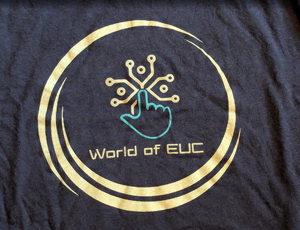 [Click on image for larger view.]
[Click on image for larger view.]
From Aug. 4 to midday on Aug. 7, 2025, I had the privilege of attending EUC World Amplify at the McNamara Alumni Center on the beautiful University of Minnesota campus.
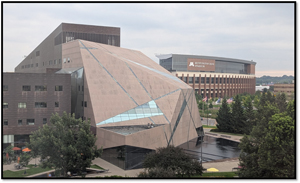 [Click on image for larger view.]
[Click on image for larger view.]
I observed firsthand the depth, breadth, and vibrancy of a vendor-agnostic, community-driven conference that is establishing itself as one of the most important gatherings for the end-user computing (EUC) community.
Day One: Arrival and Early Impression
The opening reception on Monday evening, the day that I arrived at the conference, served as a preamble to the conference itself, providing opportunities to reconnect with colleagues, establish new contacts in the EUC community, and set the stage for the formal sessions that would begin the next day.
Day Two (Conference Day One): Keynotes, Industry Shifts, and Emerging Trends
The formal program began with a keynote panel moderated by Stephen Wagner, which examined the current and future state of end-user computing and virtualization. The discussion was framed by the significant industry developments of recent months, most notably Broadcom's acquisition of VMware.
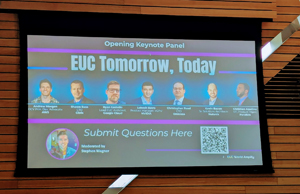 [Click on image for larger view.]
[Click on image for larger view.]
The panel addressed how such changes are influencing vendor relationships, prompting organizations to explore platform-neutral strategies, alternative hypervisors such as Citrix XenServer and Nutanix AHV, and partnerships like Omnissa with Nutanix. The underlying objective across these strategies is to balance cost efficiency, operational simplicity, and improved user experience.
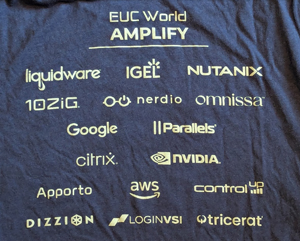 [Click on image for larger view.]
[Click on image for larger view.]
Of course, no conference in the last couple of years would be complete without AI emerging as a theme. Presenters and panelists discussed AI's role in enhancing virtual desktop infrastructure (VDI) and related technologies--ranging from intelligent bandwidth management and AI-driven noise suppression to administrative "copilot" tools and secure AI gateways capable of optimizing workload routing. These applications underscored AI's transition from a conceptual trend to a practical, value-generating capability.
Liquidware was one of the first sponsors of EUC World and had a sponsored session on the first day. It focused on Stratosphere UX metrics and real-time remediation tools. Their approach demonstrated how unified workspace management can be applied across Windows and Linux platforms, whether deployed physically, virtually, or in the cloud.
IGEL was another sponsor of the event that had a session on day one. After Jason Mafera (Field CTO from IGEL) described IGEL's transition from a hardware company to a software company, focusing on their endpoint operating system, and talked about the security features of IGEL and how it can reduce an organization's cost by extending the lifecycle of a company's hardware, he made an announcement that caught my ear.
IGEL, known for its Linux-based secure endpoint operating system, expanded on its client-side hypervisor strategy during the session. They said it would strengthen its offerings in security, business continuity, and hardware longevity. They said this centrally managed hypervisor can deploy virtual machines directly to endpoint devices, supporting a wide range of guest operating systems from DOS to Windows 11--even on hardware that doesn't meet Microsoft's requirements--by applying them through the hypervisor layer.
The VMs can be deployed and operate in various modes, such as user, window, or kiosk mode, and are designed to be immutable, benefiting from IGEL OS's proven track record of zero real-world compromises. This security-first approach is reinforced by a read-only OS, a full chain of trust from hardware to OS, encrypted components, and the ability to control Windows infrastructure even during a cyber incident centrally.
The final presentation that I attended was on Benny Tritsch's EUC Score. His presentation emphasized a user-centric approach to cloud-based Windows environments, asserting that user satisfaction is paramount for successful deployments. It criticized the common practice of blaming the network or storage for poor performance, advocating instead for proactive testing and optimization. This is achieved through sophisticated testing that simulates diverse user activities and network conditions, precisely identifying issues like application unresponsiveness, video distortion, or screen refresh delays. The ultimate objective is to deliver a seamless and artifact-free user experience, prioritizing metrics that directly impact the end-user.
Following the first day, I participated in a Happy Hour sponsored by ControlUp, Google, Tricerat, and IGEL at Top Golf. During the event, attendees were given a chance to take a few swings using the virtual golf simulator and to catch up with others in the EUC community.
 [Click on image for larger view.]
[Click on image for larger view.]
Day Three (Conference Day Two): Frameworks, Practical Solutions, and Vendor Perspectives
The following day commenced with a keynote by Ruben Sprujit, Vice President of Product and Field CTO at Dizzion. Interweaving personal anecdotes--including a life-altering accident--with professional insights, Sprujit discussed his Hexagrid, a conceptual framework comprising six primary pillars, 27 subcategories, and more than 280 vendors. This model provides a structured means of understanding the complex EUC ecosystem, incorporating domains such as access, virtual desktops, application delivery, and environment management. AI's influence was again highlighted as a pervasive enabler within this structure.
Citrix, one of the event's sponsors, delivered a presentation by Miguel Contreras on the newly released Long Term Service Release (LTSR) of Virtual Apps and Desktop 2057. With more than 400 new features--spanning automated healing, enhanced security measures, improved multi-monitor support, and broader optimization across cloud providers- the release was notable not only for its scope but for its direct alignment with user needs. The inclusion of Windows 11 support, developed in close collaboration with Microsoft, further emphasized Citrix's customer-focused approach.
I attended a breakout session led by Chris Hildebrandt, where he addressed the practicalities of automation in enterprise environments. Using the example of expanding virtual machine disk space--a routine yet often cumbersome task--he demonstrated how incremental automation, combined with proactive monitoring and management oversight, can yield both efficiency gains and operational resilience.
Later, a candid panel discussion examined the evolving role of Citrix in the EUC landscape. Participants, many of whom were former Citrix experts, spoke openly about the effects of corporate restructuring, licensing adjustments, and the transition from public to private ownership. Their consensus was that the community must maintain its independence and critical voice, even as it engages with major vendors.
A founder partner roundtable brought together executives from IGEL, Liquidware, Nerdio, and 10ZiG to discuss the future of EUC delivery models. Their dialogue revealed common priorities: ensuring sustainability, maximizing hardware efficiency, maintaining predictable cost structures, and adopting zero-trust security principles. While the conversation was serious in tone, moments of levity--such as light-hearted discussion about personal hobbies--added a welcome human dimension.
Nutanix had a session where they made a compelling case for its approach to high-performance VDI. Kevin Bacon outlined how consolidating hypervisors into a unified stack, coupled with technologies like data locality and shadow clones, enables greater efficiency. Their flexible architecture, designed to integrate seamlessly with partners such as Citrix and Omnissa, aims to preserve user experience while accommodating hybrid deployments.
After the conference ended for the day, I met up with two of the day's presenters, Ruben and Benny, along with Robin Brandl and DJ Eshelman, for dinner and more EUC talk.
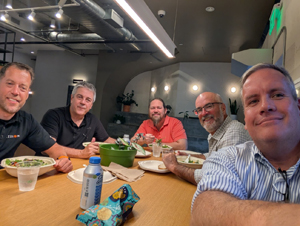 [Click on image for larger view.]
[Click on image for larger view.]
Final Thoughts
My first days at Amplify exceeded the lofty expectations that I had for it. However, my fourth day at the conference is what blew me away. You can read about it in my next post.
About the Author
Tom Fenton has a wealth of hands-on IT experience gained over the past 30 years in a variety of technologies, with the past 20 years focusing on virtualization and storage. He previously worked as a Technical Marketing Manager for ControlUp. He also previously worked at VMware in Staff and Senior level positions. He has also worked as a Senior Validation Engineer with The Taneja Group, where he headed the Validation Service Lab and was instrumental in starting up its vSphere Virtual Volumes practice. He's on X @vDoppler.